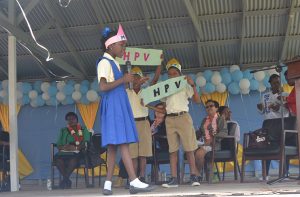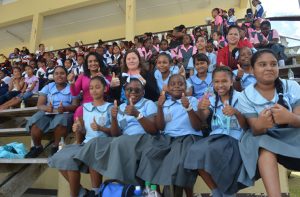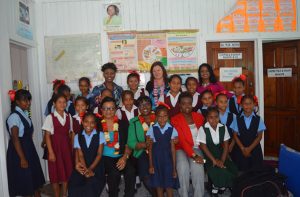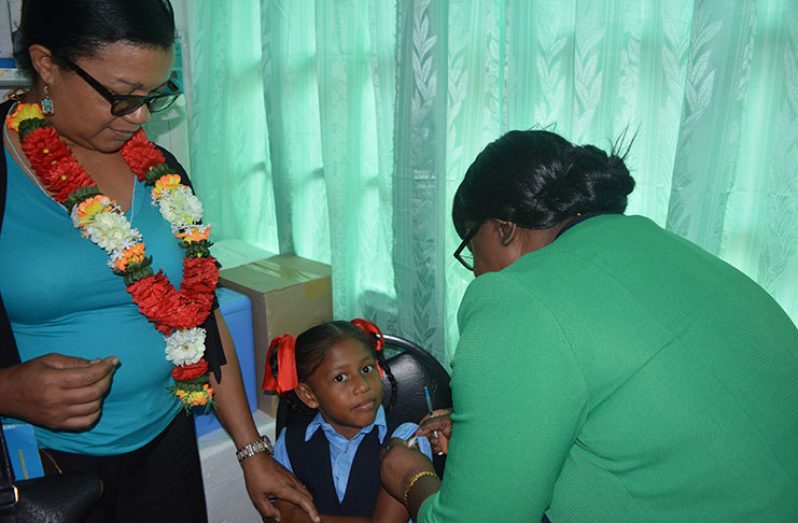–as gov’t launches groundbreaking national HPV vaccination programme
THE National HPV Vaccination Programme was launched in Bartica, with Minister within the Ministry of Public Health, Dr. Karen Cummings immunizing the first child as the Ministry joins its global partners in safeguarding this generation of girls from developing cervical cancer in the future.
The Human Papilloma Virus (HPV) is the most common sexually-transmitted infection (STI), and has the potential to develop into genital warts and cancer, in particular cervical cancer, among women. But the risk of developing cervical cancer can be eliminated using the HPV vaccine, which is most effective when used on adolescents.

From now to the month of December, the Public Health Ministry, through the Maternal and Child Health Department (MCH) is aiming to immunize approximately 36, 000 girls between the ages of nine and 13, once permission is granted by their parents. The second dose of the vaccine will be administered six months after.
On Monday, the first batch of girls was vaccinated at the Bartica Health Centre, shortly after the national programme was launched at the Bartica Community Centre Ground under the theme, “It’s a Big Deal: Be HPV Free”, with major backing from the Pan-American Health Organisation and World Health Organisation (PAHO/WHO) and the United Nations Children’s Fund (UNICEF).
Referencing the WHO, Minister Cummings, while delivering the feature address at the launching, pointed out that cervical cancer is the second most common cause of cancer among women living in developing countries.
“In 2012, there were approximately 445, 000 new cases of cervical cancers in these developing countries,” she said.
“According to the World Health Organisation, in 2012, an estimated 270, 000 women died from cervical cancer. More than 85 per cent of these deaths occurred among women living in low and middle-income countries,” Minister Cummings added as she painted a clear picture of the global situation.
GUYANA SITUATION
In Guyana, she said, the situation is no different. In 2014, when an assessment was done over a 10-year-period, it was found that cervical cancer was the second most common cause of cancer among women. According to that study, the average incidence rate of cervical cancer in Guyana was 46.9 per 100, 000.
“The data demonstrated that a mere 4 per cent of the cervical cancers that occurred among the Guyanese women over the 10-year-period were diagnosed at stage one whereas the majority of the patients were diagnosed at stage 4 which contributed to an average annual mortality of 267 per 100, 000,” the Public Health Minister further pointed out.
It was based on these alarming statistics, that WHO Technical Advisory Group on Immunization in 2016 recommended that all countries in the Americas introduce the HPV vaccines.

Minister Cummings said in keeping with the WHO’s recommendations, the Public Health Ministry has opted to launched a National HPV Vaccination Programme for a second time. The first programme was carried out from 2012-2014.
This time around, the Ministry is aiming to achieve a minimum of 95 percent coverage of the targeted population – girls 9-13.
“The Ministry of Public Health is committed to this preventative initiative against the development of cervical cancer as is evidenced by the provision of the funds required for the purchase of the vaccines and the other preparations needed for a successful HPV Vaccination campaign,” Minister Cummings told the gathering of school girls, parents, medical personnel and local and regional officials that had converged at the ground for the launching.
Even as she applauded the “hard-working” MCH staff and their Director, Dr. Ertenisia Hamilton for carrying out an aggressive sensitization campaign, the Public Health Minister underscored the importance of continued education.
INTERVENTIONS
“The Ministry of Public Health has recognized that public education interventions can greatly increase HPV and HPV vaccine knowledge among groups influential to the HPV vaccination behaviors of adolescent females. Therefore, as a Ministry we will continue to drive the message of the numerous benefits the HPV vaccine provides, in a coordinated effort to erase the profound ignorance that currently prevails about this life saving vaccine,” Minister Cummings stated.
While the Public Health Ministry and global partners such as PAHO/WHO and UNICEF are important stakeholders in this national effort, she said it must be noted too that parents, healthcare providers and teachers must also key stakeholders.
“Parents are typically the main decision makers in choosing whether their adolescent daughters receive the HPV vaccine. Therefore it is imperative that we carefully map our target audiences and ensure they receive clear unambiguous communication about the numerous benefits of the HPV vaccine,” she added.
UNICEF Representative, Ms Sylvie Fouet, in delivering brief remarks said UNICEF is pleased to be joining forces with the Public Health Ministry and PAHO/WHO to carry this national programme.

UNICEF, she said, has been working with civil society with the aim of building awareness among the populace. Fouet said in addition to the medical aspect of the programme, it has a community aspect that deals with acceptance.
Given the situation in Guyana, she said HPV vaccination programme is strategy being employed to prevent the spread of cervical cancer.
PAHO/WHO Country Office Advisor for Maternal and Child Health, Dr. Janice Woolford told those present that the expanded programme of immunization is a priority initiative for PAHO/WHO since it has a significant impact on disease prevention.
“PAHO/WHO will continue to support the vaccination programme through building capacity, social media campaign activities and providing access to remote services,” Dr. Woolford assured. The Mayor of Bartica Gifford Marshall and Deputy Mayor Kamal Persaud were among the officials at the launch.
When the HPV Vaccination was first launched in Guyana between 2012-2014, some 21,600 doses were administered. Vaccines were administered to girls 11-13 in Regions Three, Four, Five and Six.




.png)









